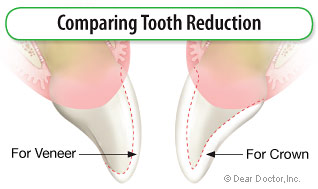Artistic Repair Of Front Teeth With Composite Resin
Taking Tooth Colored Composite Resin Dentistry To The Highest Level Of The Art

If You Look Good, We Look Good
A biomimetic (“bio” – life; “mimetic” – mimicking) approach to restoring decayed, fractured or broken teeth involves nothing short of learning how to mimic nature. And emulating nature successfully requires a thorough knowledge and appreciation of the structure of teeth and how to apply appropriate restorative materials to recreate function — nature's art in tooth forms. This means knowing what to use, when and how to use it, all with a great deal of artistic talent. Nowhere is this more important than in the restoration of teeth in the “smile line,” the ones that really show and are so important — because if you look good, we look good!
Composite resins are tooth-colored materials that can actually be applied to the remaining surfaces of teeth to replace lost tooth structure in such a way as to actually make them one, blending and exactly matching the physical characteristics and color of natural teeth, and actually strengthening them in the process. Most importantly, modern composites physically adhere by actually bonding to the two elements that teeth are composed of, dentin and enamel. Major advances have resulted from the study and understanding of how the crowns of teeth actually flex or give under biting force and how restorative materials can be used to the greatest effect in the way they interact. And, best yet, composites can be used to restore teeth directly — they are applied directly to the teeth in the dental office in a single appointment. That means no temporaries and no outsourcing to dental labs for fabrication, which also means less cost and time [Figure 1-4].
Composite resins have been advocated for decades as a means to conservatively restore minor, moderate, and even large defects in teeth caused by decay or trauma. Their indication is predicated on the need to preserve as much healthy tooth structure as possible while using these synthetic composite resin materials to completely replace and augment lost tooth structure by adhesive dentistry. The challenges involved in retaining such restorations have been resolved by bonding, the implementation of sound adhesive dental techniques, as discussed in Dear Doctor magazine's previous article “The Natural Beauty of Tooth Colored Fillings.” This article discusses the use of techniques for the successful restoration of front teeth, and the high degree of artistry that can be achieved.
 |
 |
| Figure 1: Chipped upper front teeth resulting from minor trauma, and spaced lowers, create small but significant cosmetic dilemmas | Figure 2: A conservative yet natural looking repair of missing tooth structure accomplished in one office visit |
 |
 |
| Figure 3: Minor chipping of the front teeth with excessive space between adjacent teeth creating a cosmetic compromise | Figure 4: Composite restorations can modify tooth shape, form and color to correct spacial relationships and enhance a smile |
| Photos provided by Dr. Newton Fahl, Jr. | |
Material Choices — Porcelain Or Composite Resins For Front Teeth
Today's composite resins allow restorations to replace moderate loss of tooth structure in such a way as to avoid further tooth removal, while bonded porcelains are recommended to treat more perilous situations, such as worn, root canal treated or fractured teeth. This has resulted in considerable improvements both from a medical/biologic aspect as well as a social/economic aspect, as these newer materials are more conservative and cheaper.
The decision of which material to use is a critical one made by your dentist based on scientific understanding, experience and clinical judgment of the situation at hand. When deciding between direct composite resin restorations and indirect techniques like porcelain restorations (crowns or veneers, fabricated in a laboratory), dentists must address several considerations, some of which are clinical and others artistic or creative in nature. Although 20 years ago it appeared that weaknesses in direct composite bonding involved the composite material itself, manufacturers have made vast improvements to the formulations of direct composites that have resulted in enhancements to their strength, aesthetics, and reliability.
The decision of which material to use is a critical one made by your dentist based on scientific understanding, experience and clinical judgment of the situation at hand.
Composite restorations generally are one-step “single-visit” procedures, carried out in the dentist's office. Direct composite resin restorations require technique and artistic skill to place them. They are commonly indicated for trauma to the front teeth in which portions of the enamel, or enamel and dentin of the teeth, are broken or chipped. They are most often used to restore decayed areas of the front teeth where they contact each other. They can be used to reshape teeth for closing small spaces and correcting other minor irregularities of tooth position. Composite resins are often used to repair trauma to the front teeth of younger individuals involved in contact or other sports where there is continuing risk of injury and until the person is older and the teeth more mature. In these situations, composites may have more limited longevity. In addition to wear, they may also discolor over time. When appropriate, more permanent restorations can be planned and fabricated to replace restorations that have aged and no longer appear aesthetically pleasing or have otherwise become defective.
 |
| Figure 5: Illustrates how much tooth surface is removed for a traditional veneer and crown. Composite resins are a more conservative alternative. |
Although bonded porcelain veneers have demonstrated excellent aesthetics, they have traditionally required more tooth preparation than direct composite restorations. In addition to restoring teeth and replacing lost tooth structure they are also used to change tooth color, generally lightening or enhancing both the color and tooth shape. And despite the fact that porcelain veneers have shown the best overall survival, they, too, do not demonstrate a permanent life expectancy. Unlike composite resin restorations, porcelain laminate veneers and crowns require the removal of tooth structure of varying amounts in order to retain and bond them into position [Figure 5]. They also require the skills of a dental laboratory technician to fabricate them thus creating the need for more than one visit to successfully implement and restore the teeth. All this is generally reflected in their higher cost.
In a nutshell, composite resin restorations are very conservative of precious tooth structure. At a time when patients and dentists alike desire minimally invasive approaches to treatment, the direct composite resin restoration may be more advantageous.




